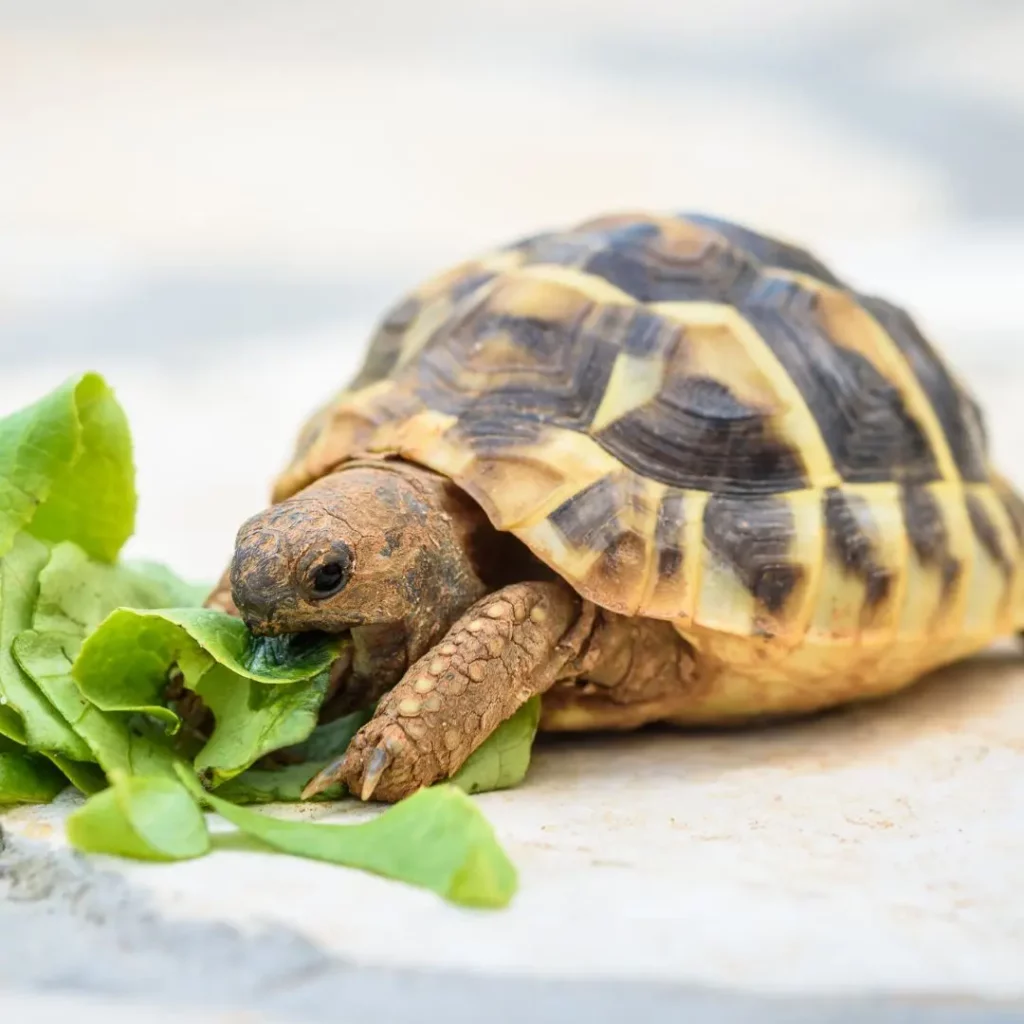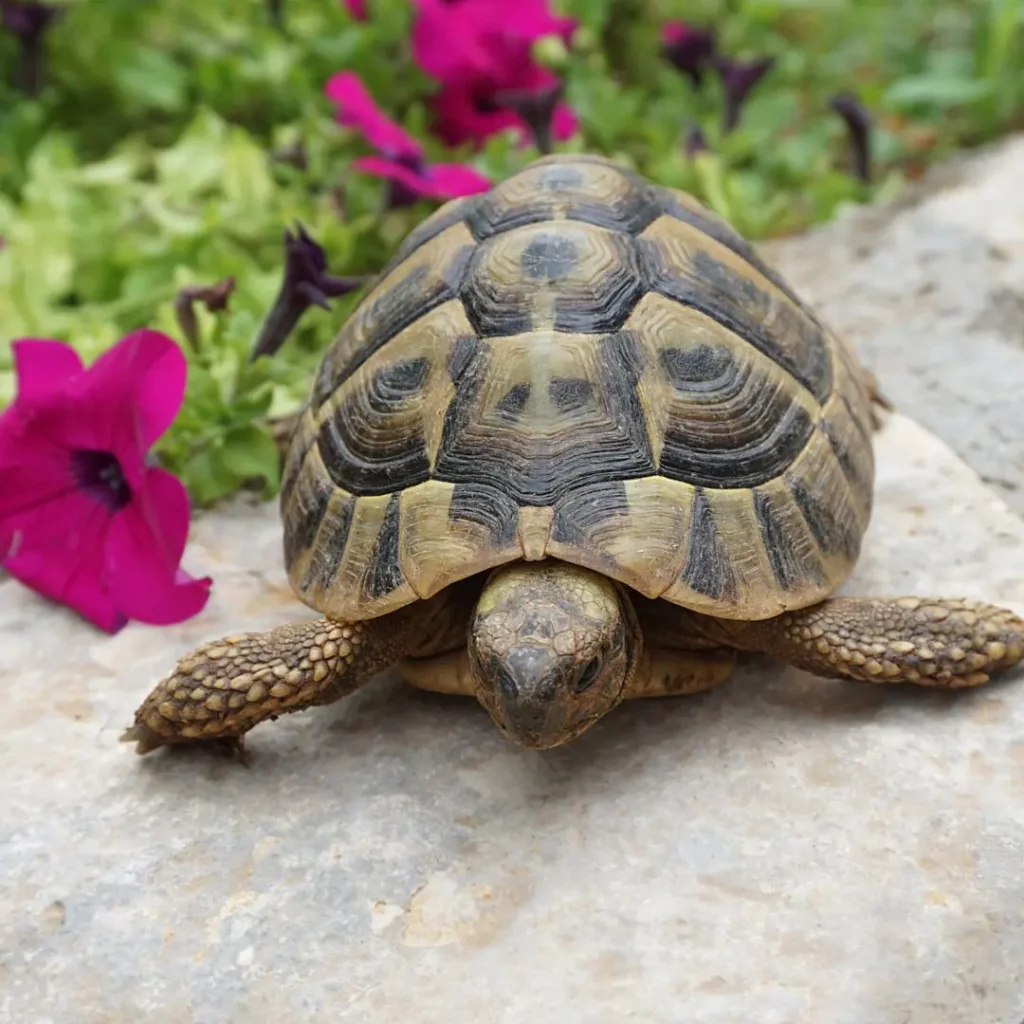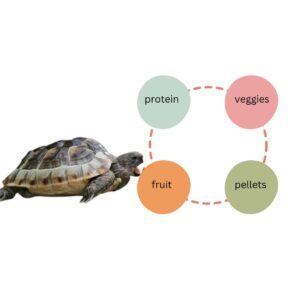Turtles are an excellent choice for a long-living pet – they’re well-known for their longevity, often living for decades! Although the type of species and their genetics mostly determine how long they can live as well as:
- Diet and Nutrition
- Housing/Habitat
- Temperature
- Lighting
- Stimulation/Exercise
But what’s their average lifespan? How long do pet turtles live?
In this comprehensive guide, I’ll answer these questions, explain the common factors and how to take proper care of your turtle(s) to increase their lifespan and show you can tell the approximate age of a turtle.
Table of Contents
The Average Lifespan of Pet Turtles
The average turtle’s lifespan depends primarily on the species. Most turtles can live 10~20 years in captivity but can surpass this range with proper care.
Here are some of the most popular types of pet turtles and their average lifespan:
| Turtle | Lifespan |
| Red-eared Slider | Typically more than 40 years |
| Yellow-bellied Slider | About 40 years or more |
| Diamond-back Terrapin | Up to 40 years |
| Mississippi Map | 15~20 years |
| Box turtles | Up to 20 years |
| Painted turtles | 20~40 years |
| Spotted turtles | About 50 years or more |
The Factors Affecting a Turtle’s Lifespan In Captivity
While genetics play a significant role in their longevity, a pet turtle’s primary determinant is the quality of care it receives.
Owning a turtle (or tortoise) is a long-term commitment. By understanding their specific needs and providing them with the highest quality of care, we can unlock their potential for incredible longevity.
Remember: It’s not just about years but about fostering a fulfilling life filled with comfort and the joy of companionship.
Here are some of the key factors that impact a turtle’s lifespan in captivity:
Diet and Nutrition

Turtles are mostly omnivores, meaning their natural diet consists of plant- and meat-based food. That’s why it’s important to provide a balanced diet that provides a variety of healthy nutrients to support their dietary needs.
However, there are all kinds of turtle species, each with their preferences and needs. So, what do pet turtles eat?
For example, herbivorous pet turtles can have a varied diet including leafy greens, vegetables, and fruits, along with commercial turtle pellets for added nutrition.
On the other hand, carnivorous pet turtles thrive on a diet mainly consisting of appropriately-sized prey items like feeder fish and insects.
For omnivorous pet turtles, you should provide a balanced diet with plant matter and animal protein. You can achieve this by offering insects, fish, low-fat cooked meat, fresh veggies, fruits, and plants.
To help you better understand what your turtle’s diet should include, I listed the food experienced herpetologists recommend for popular, common pet turtles.
- Pellets: Commercial nutrient pellets that mostly contain protein, healthy fats (including Omega 3 and 6), and fiber.
- Vegetables: dark leafy greens, collard greens, mustard greens, carrots, Swiss chard, kale, parsley, green beans, turnips, etc.
- Fruits: apples, tomato, guava, kiwis, pears, bananas, mango, grapes, star fruit, raisins, peaches, melons, etc.
- Animal-based protein: hard-boiled eggs, slugs, grasshoppers, crickets, moths, and different kinds of worms.
- Flowers: Herbivore turtles, like Box turtles for example, also enjoy munching on flowers like dandelions, roses, hibiscus, geranium, etc.
This food provides the following beneficial nutrients:
- Vitamin A: Keeps your turtle’s eyes, skin, and shells healthy and vibrant. It also helps prevent infections and promotes overall growth and development.
- Vitamin B: Vital for energy metabolism, nerve function, and overall health.
- Vitamin D3: Vitamin D from the healthy veggies like kale and spinach (and also from sunshine) helps turtles absorb calcium and build strong bones and shells.
- Vitamin E: This antioxidant protects your turtle’s cells from damage and keeps their immune system functioning properly.
- Calcium: This mineral forms the building blocks of your turtle’s bones and shells. It’s critical for proper growth, development, and preventing metabolic bone disease.
- Iron: This mineral carries oxygen throughout your turtle’s body and is important for healthy red blood cells. Otherwise, a lack of iron can lead to anemia.
- Potassium: This mineral helps regulate blood pressure, muscle contractions, and nerve function.
Housing/Habitat
Like any other pet, turtles also require an environment that covers their needs and promotes their well-being. But should you keep your turtles outdoors or indoors?
Turtles should live outdoors in an environment that mimics their natural habitat in the wild. But this doesn’t always apply – for instance, if you live in an area with low temperatures during chilly seasons, you should keep your turtle(s) inside.
And some species may require extra measures. For example, if you have an aquatic turtle, you can keep them inside or outside. But aquatic types of turtles must be in the water – they need spacious tanks with proper filtration.
However, a strictly aquatic turtle could spend an hour or two on the land/ground if wet and have water nearby.
On the other hand, other species need land and water areas for basking and swimming, especially during warm days. Failing to provide the proper environment can lead to stress, illness, and a shortened lifespan – and we don’t want that.
Here are a few mandatory safety measures to consider before setting up housing for your turtle(s):
- Size: An enclosure that’s too small can restrict your turtle’s movement, leading to muscle atrophy and health problems – the best option is to keep them outside in an environment with plenty of space, green, and fresh air.
If you keep your turtle(s) inside, ensure you expand their home accordingly as they grow.
- Cleanliness: Unclean areas are breeding grounds for bacteria and parasites, which can make your turtle sick. Regular cleaning and maintenance of your turtle’s housing/tank is critical for their health. This includes removing waste, changing water, and disinfecting surfaces.
- Safety: Your turtle’s enclosure should be a safe haven. Ensure it’s escape-proof and free from dangers like sharp objects, toxic plants, and electrical cords – though you may not have to worry about this if they’re in a tank.
Also, be mindful of potential predators like raccoons, opossums, ferrets, or weasels. Note that some household pets can also pose a threat for your turtle(s), so keep them away from your turtle’s enclosure.
By providing your turtle with a spacious, clean, and safe environment that caters to their specific needs, you can significantly improve their quality of life and contribute to their longevity.
Temperature

Maintaining optimal temperatures is important for your turtle’s well-being. Like us, they rely on the right temperature to regulate their body functions, digest food properly, and stay active.
Here’s why maintaining an appropriate temperature is essential:
- Metabolism and digestion: Temperature directly impacts your turtle’s metabolic rate. Their metabolism speeds up in warmer temperatures, allowing for faster nutrient absorption and digestion.
On the other hand, colder temperatures slow down their metabolism, making it harder for them to digest food and use nutrients effectively.
- Immunity: Optimal temperature also plays a vital role in strengthening your turtle’s immune system. When the temperature is too cold, their immune response weakens, making them more susceptible to infections and diseases.
- Growth and development: Young turtles are particularly sensitive to temperature. The right temperature range helps them grow and develop properly, ensuring healthy bone formation and shell growth.
- Overall Health and activity: Maintaining the ideal temperature range keeps your turtle active, alert, and exhibiting natural behaviors. These include basking, swimming, exploring their environment, and foraging for food.
In contrast, incorrect temperatures can lead to lethargy, decreased appetite, dehydration, and other potential health problems.
Lighting
Just like temperature, lighting is another critical factor that can determine the life quality of your turtle(s). They rely on light to regulate various bodily functions, stay active, and navigate their environment – replicating the natural sunlight cycle is mandatory for turtles indoors.
The proper lighting helps your turtle with:
- Vision and navigation: Turtles rely on light for vision and navigation. Adequate lighting helps them see their surroundings, identify food, and avoid obstacles.
- Circadian rhythm: Like most living beings, turtles have a natural circadian rhythm regulated by light and darkness. A day-night cycle with proper lighting helps maintain their internal clock, promoting healthy sleep patterns and activity levels.
- Vitamin/Mineral synthesis: Certain types of light, specifically UVB (ultraviolet B light) rays, play a vital role in vitamin D3 absorption. Vitamin D3 helps turtles absorb calcium from their food, which is mandatory for strong and healthy bones and shell development.
Stimulation and Exercise (Enrichment)

Like other pets, turtles require mental and physical stimulation to thrive. Providing opportunities to forage, explore, and engage in natural behaviors can significantly improve their quality of life and prevent boredom.
Offering puzzle feeders, hiding treats, and creating different textures and landscapes within their enclosure are just a few common ways of enriching their quality of life.
To help you out, I listed some of the most effective ways to enrich your turtle’s well-being.
A bored turtle can become stressed and even fall ill. Luckily, there are plenty of ways to keep your shelled friend happy and engaged. Here are five effective ways to provide enrichment for your pet turtle:
- Puzzle feeders and hidden treats: Instead of simply dropping food into their bowl, challenge your turtle’s problem-solving skills with a puzzle feeder. These feeders come in various designs, requiring your turtle to push levers, nudge balls, or navigate mazes to access their food.
You can also turn mealtime into a treasure hunt! Hide your turtle’s food around their enclosure in different locations. This encourages them to explore their environment and use their senses to find their reward.
This not only provides mental stimulation but also encourages natural foraging behavior.
- Varied textures and landscapes: Adding different textures and landscapes to your turtle’s habitat can significantly increase their physical and mental stimulation and improve their life quality – and yes, it will also make their home look prettier 🏠.
Include rocks, branches, logs, and even climbing platforms to provide them with opportunities for climbing and hiding.
You can also use different substrates, like sand or gravel, to create a more natural and stimulating environment.
- Toys and activities: Try to create tunnels, mazes, or even small obstacle courses for your turtle to explore. You can also use ping pong balls, plastic cups, or other safe objects for them to push around and interact with.
Not sure what toys to buy for your turtle? Here are a few ideas:
- Multipet International Komodo Ping Pong Balls
- Penn-Plax Reptology Floating Turtle Pier and Basking Platform
- Treat Ball Toy by Tirifer
- Interactive playtime: Spend some quality time interacting with your turtle. Hand-feed them treats, talk to them gently, and let them bond with you. You can even teach them simple tricks, like following a target or swimming through hoops.
This interaction provides mental stimulation and strengthens your connection with your pet.
Common Health Issues That Can Affect Your Turtle’s Lifespan
Understanding the common health problems that can affect your turtle’s longevity is critical.
So be aware of the following health issues:
Vitamin A Deficiency
Turtles need vitamin A for healthy eyes and skin. A vitamin A deficiency can lead to swollen eyelids, runny nose, and difficulty seeing, especially in low light.
This condition can worsen if not addressed promptly, so ensure your turtle has a diet rich in vitamin A or provide supplements as your veterinarian recommends.
Abscesses
Like humans, turtles can develop abscesses, localized infections often caused by bacteria or fungi. These appear as swollen, painful bumps on the skin or shell.
Early detection and treatment with antibiotics are critical to prevent the infection from spreading and causing more serious damage.
Common symptoms include:
- lethargy
- loss of appetite
- difficulty moving
Gastrointestinal Parasites
These tiny, unwelcome guests can invade your turtle’s digestive system, often causing:
- weight loss
- diarrhea
- vomiting
- loss of appetite
Internal parasites are invisible to the naked eye, so regular fecal tests by a veterinarian are necessary for detection and treatment.
Pro tip: Deworming medications can help eliminate these parasites and restore your turtle’s health. But don’t begin the procedure without consulting your vet first!
Infected Shells
Also known as shell rot, an infected shell occurs when bacteria or fungi attack the shell, causing discoloration, softening, and pitting. Shell infections can be painful and affect your turtle’s mobility.
Maintaining proper water quality and humidity in your turtle’s enclosure is vital for preventing this health problem. If you suspect an infection, consult your veterinarian for appropriate treatment – may involve antibiotics or surgical debridement.
Respiratory Infections
Exposure to drafts, cold temperatures, or unsanitary conditions can make your turtle susceptible to respiratory infections. Symptoms include:
- difficulty breathing
- wheezing
- discharge from the nose or eyes
Ensuring a warm, clean environment and providing a basking area where your turtle can warm up can help prevent these issues.
How to Tell the Age of Your Turtle?
Determining the age of a turtle can be tricky and finding out the real age of adopted turtles is hardly possible. But don’t worry – I’ve found some interesting methods you can try.
- Hatch date: The most accurate way to know your turtle’s age is if you have the hatch date. This information might be available if you adopted them from a reputable breeder or rescue.
- Shell rigidity: A young turtle’s shell is softer and more flexible than an adult’s. Gently touch the shell without applying pressure. A soft shell likely indicates a turtle under nine months old, as it takes about six to eight months for a turtle’s shell to become firm.
- Scute rings are the bony plates on your turtle’s shell. Each scute has rings that, like tree rings, represent periods of growth. Count the rings on one scute and divide the number by two to determine an estimated age.
- Shell length and weight: As turtles grow, their shells become larger, and their weight increases.
Try to measure the length of your turtle’s shell and compare it to a size chart for their species. Don’t forget also to weigh your turtle and compare it to the average weight for its species and size.
This can offer a rough estimate of their age, but remember that growth can vary depending on diet and health. This may be the least accurate way to tell the age of turtles.
However, it’s important to remember that most of these methods aren’t exact and only provide an educated guess.
Why do turtles live so long?

The impressive longevity of turtles is a fascinating puzzle that scientists are still unraveling. Several factors contribute to their long lifespans, including:
1. Slow Metabolism:
Turtles are ectothermic, meaning they rely on external sources for warmth. This means they have a slower metabolism than mammals and birds, who generate their own body heat.
A slower metabolism translates to less wear and tear on their bodies, potentially delaying aging and the onset of age-related diseases.
2. Telomeres:
Telomeres are protective caps at the ends of chromosomes that shorten with each cell division. When telomeres become too short, cells can no longer divide, leading to aging and death.
Studies suggest that turtles have unusually long telomeres, which may contribute to their extended lifespans.
3. DNA Repair Mechanisms:
Turtles have efficient DNA repair mechanisms that help them fix damage to their genetic material. This ability to maintain DNA integrity can play a significant role in delaying aging and promoting longevity.
4. Immune System:
Turtles possess robust immune systems that effectively fight off infections and diseases. This strong defense allows them to survive longer and remain resilient to environmental stressors.
5. Evolutionary Advantages:
Some scientists believe that the long lifespans of turtles may offer an evolutionary advantage. By living longer, turtles have more opportunities to reproduce and pass on their genes to future generations.
6. Other factors:
- Shell Protection: Their hard shells offer physical protection from predators and harsh environments, increasing their chances of survival.
- Limited Predators: Adult turtles have relatively few natural predators, further contributing to their ability to live long lives.
- Healthy Diet: Herbivorous turtles consume a healthy diet of plants and fruits, providing them with essential nutrients for optimal health and longevity.
While scientists continue to explore the exact mechanisms behind their long lifespans, it’s clear that turtles are remarkable creatures with unique adaptations that allow them to thrive for decades. Their longevity serves as a reminder of the incredible diversity and resilience of life on Earth.
My Senior Paws is a participant in the Amazon Services LLC Associates Program, an affiliate advertising program designed to provide a means for sites to earn advertising fees by advertising and linking to Amazon.com. We also participate in other affiliate programs which compensate us for referring traffic.



